ALP-101
ALKALOPHILIC PROTEINASE from Streptomyces sp.

PREPARATION and SPECIFICATION
| Appearance | White amorphous powder, lyophilized |
|---|---|
| Activity | GradeⅠ 20U/mg-solid or more |
| Stabilizer | Ca++ |
PROPERTIES1)
| Stability | Stable at −20℃ for at least one year (Fig.1) |
|---|---|
| Molecular weight | approx. 50,000 |
| Isoelectric point | 8.7 |
| Inhibitors | Diisopropyl fluorophosphate, EDTA |
| Optimum pH | ≧12(Fig.3) |
| Optimum temperature | 60℃(Fig.4) |
| pH Stability | pH 5.0−11.5 (25℃, 24hr)(Fig.5) |
| Thermal stability | below 50℃ (pH 8.3, 15min)(Fig.6) |
APPLICATIONS1,2)
This enzyme is more active at a higher pH range than the known alkaline proteases, showing the proteolytic activity even in 0.2N NaOH solution. This enzyme is useful for proteolysis of insoluble protein and for structure investigation of protein.
ASSAY
Principle

The appearance of peptides is measured as tyrosine equivalent at 275nm by spectrophotomertry.
Unit definition
One unit causes the increase of optical density at 275nm corresponding to one micromoloe of tyrosine per minute under the conditions described below.
Method
Reagents
| A. Casein solution | 0.6% [Suspend 3.0g of Hammersten milk casein (ICN Biomedicals) in 20ml to 0.1N NaOH solution and dissolve by warming in a hot water bath (60℃). Cool down to room temperature, add 50ml of 0.1M borax and 400ml of H2O and, after adjusting the pH to 11.0 with 1.0N NaOH solution, fill up to 500ml with H2O](Stable for one week if stored at 0-5℃) |
|---|---|
| B. TCA mixture | 0.11M Trichloroacetic acid (TCA) containing 0.22M sodium acetate and 0.33M acetic acid |
| C. Enzyme diluent | 2.0mM calcium acetate |
Procedure
1.Pipette 3.0ml of substrate solution (A) into a test tube and equilibrate at 30℃ for about 5minutes.
| Concentration in assay mixture | |
|---|---|
| Borax | 8.6 M |
| Casein | 5.1mg/ml |
| Ca(CH3COO)2 | 0.29 mM |
2.Add 0.5ml of the enzyme solution* and mix.
3.After exactly 10 minutes at 30℃, add 3.2ml of TCA mixture (B) to stop the reaction
4.Incubate for further 20 minutes at 30℃
5.Filter the mixture with a filter paper and measure the optical density of the filtrate at 275nm (OD test).
At the same time, prepare the blank by first mixing the substrate solution with 3.2ml of TCA mixture (B) after 10 min-incubation at 30℃, followed by addition of the enzyme solution, and carry out the same procedure (procedure 4-5) at test (OD blank).
*Dissolve the enzyme preparation in ice-cold 10mM borax-NaOH buffer, pH 11.0 and dilute to 0.1-0.4U/ml with enzyme diluent (C), immediately before assay.
Calculation
Activity can be calculated by using the following formula :
Volume activity (U/ml) =
-
ΔOD (OD test-OD blank)×Vt×df
1.34×1.0×t×Vs
= ΔOD×df
Weight activity (U/mg) = (U/ml)×1/C
| Vt | : Total volume (6.7ml) |
| Vs | : Sample volume (0.5ml) |
| 1.34 | : Millimolar extinction coefficient of tyrosine (cm2/micromole) |
| 1.0 | : Light path length (cm) |
| t | : Reaction time (10 minutes) |
| df | : Dilution factor |
| C | : Enzyme concentration in dissolution (c mg/ml) |
REFERENCES
1)T.Nakanishi, Y.Matsumura, N.Minamiura and T.Yamamoto; Agric. Biol. Chem., 38, 37 (1974).
2)T.Nakanishi and T.Yamamoto; Agric. Biol. Chem., 38, 2391 (1974).
3)B.Hagihara, H.Matsubara, M.Nakai and K.Okunuki; J.Biol.Chem., 45, 185 (1958).
-
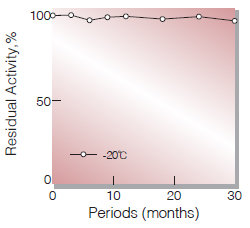
Fig.1. Stability (Powder form)
(kept under dry conditions)
-
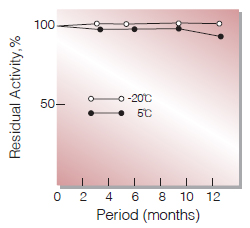
Fig.2. Stability (Powder form)
(kept under dry conditions)
-
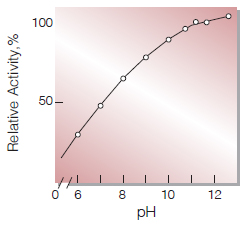
Fig.3.pH-Activity
30℃,10min-reaction in the following buffer solution:pH4.0-6.0,20mM acetate; pH7.0-9.0,50mM Tris-HCI;pH9.5-12.0 10mM borate.
-
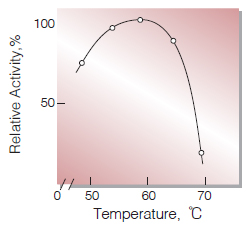
Fig.4. Temperature activity
60 min-reaction in 10mM borate buffer,pH11.0
-
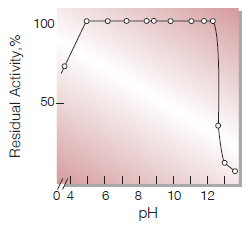
Fig.5. pH-Stability
25℃, 24hr-treatment with the same buffer as shown in Fig.2.
-
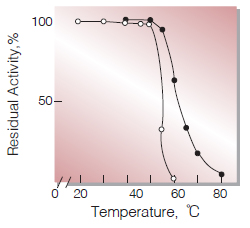
Fig.6. Thermal stability
15min-treatment with 10mM borate buffer,pH8.3: 〇――〇,without ca++; ●――●,with 2.0mM Ca++
活性測定法(Japanese)
1. 原理

ペプチドの生成量を275nmの吸光度の変化で測定する。
2.定義
下記条件下で1分間に1マイクロモルのチロシンに相当する275nmの吸光度の増加を与える酵素量を1単位(U)とする。
3.試薬
- 0.6%カゼイン溶液〔3.0gのHammerstenミルクカゼイン(ICN Biomedicals製)を20mlの0.1N NaOH溶液に懸濁し,60℃で加熱しながら溶解し,室温まで冷却したのち,次いで0.1M borax 50ml及び蒸留水約400ml加え,1.0N NaOHでpHを11.0に調整した後,蒸留水で全容を500mlとする。〕
- TCA混液(0.22酢酸ナトリウム及び0.33M酢酸を含む0.11Mトリクロロ酢酸)
酵素溶液:酵素溶液を予め氷冷した10mM borax-NaOH緩衝液,pH 11.0で溶解し,2.0mM 酢酸カルシウム溶液で分析直前に0.1〜0.4/mlに希釈する。
4.手順
1.試験管に基質溶液(A)3.0mlを採り,30℃で約5分間予備加温する。
2.酵素溶液0.5mlを加え,反応を開始する。
3.30℃で正確に10分間反応させた後,TCA混液(B)3.2mlを加えて反応を停止させる。
4.30℃で更に20分間放置後,濾紙で濾過し,濾液につき275nmにおける吸光度を測定する(ODtest)。
5.盲検は基質溶液(A)3.0mlを加えて10分間放置後,TCA混液(B)3.2mlを加えて混和し,次いで酵素溶液0.5mlを加えて調整する。以下同様に吸光度を測定する(ODblank)。
5.計算式
U/ml =
-
ΔOD(OD test−OD blank)×6.7(ml)×希釈倍率
1.34×1.0×10(分)×0.5(ml)
| = ΔOD×希釈倍率 | |
| U/mg | =U/ml×1/C |
| 1.34 | : チロシンのミリモル分子吸光係数 (cm2/micromole) |
| 1.0 | : 光路長(cm) |
| C | : 溶解時の酵素濃度(c mg/ml) |
CONTACT
お問い合わせ-
各種製品に関するご質問・ご相談はこちらよりお問い合わせください。
